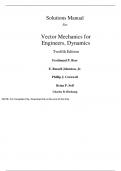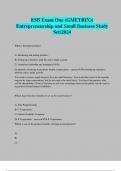Solutions Manual
For
Vector Mechanics for
Engineers, Dynamics
Twelfth Edition
Ferdinand P. Beer
E. Russell Johnston, Jr.
Phillip J. Cornwell
Brian P. Self
Charles B. Birdsong
NOTE: For Complete File, Download link at the end of this File
i
, DESCRIPTION OF THE MATERIAL CONTAINED IN
VECTOR MECHANICS FOR ENGINEERS: DYNAMICS, Twelfth Edition
Chapter 11
Kinematics of Particles
In this chapter, the motion of bodies is studied without regard to their size; all bodies are
assumed to reduce to single particles. The analysis of the effect of the size of a body and the
study of the relative motion of the various particles forming a given body are postponed until
Chap. 15. In order to present the simpler topics first, Chap. 11 has been divided into two parts:
rectilinear motion of particles, and curvilinear motion of particles.
In Sec. 11.1A, position, velocity, and acceleration are defined for a particle in rectilinear motion.
They are defined as quantities which may be either positive or negative and students should be
warned not to confuse the position coordinate and distance traveled, or velocity and speed. The
significance of positive and negative acceleration should be stressed. Negative acceleration may
indicate a loss in speed in the positive direction or a gain in speed in the negative direction.
As they begin the study of dynamics, many students are under the belief that the motion of a
particle must be either uniform or uniformly accelerated. To destroy this misconception, the
motion of a particle is first described under very general conditions, assuming a variable
acceleration which may depend upon the time, the position, or the velocity of the particle (Sec.
11.1B). To facilitate the handling of the initial conditions, definite integrals, rather than
indefinite integrals, are used in the integration of the equations of motion.
The special equations related to uniform and uniformly accelerated motion are derived in Secs.
11.2A and 11.2B. Before using these equations, students should be warned to check carefully that
the motion under consideration is actually a uniform or a uniformly accelerated motion.
Two important concepts are introduced in Sec. 11.2C: (1) the concept of relative motion, which
will be developed further in Secs. 11.4D, 15.2B and (2) the concept of dependent motions and
degrees of freedom.
The first part of Chap. 11 ends with the presentation of several graphical methods of solution of
rectilinear-motion problems (Sec. 11.3). This material is optional and may be omitted. Several
problems in which the data are given in graphical form have been included.
The second part of the chapter begins with the introduction of the vectors defining the position,
velocity and acceleration of a particle in curvilinear motion. The derivative of a vector function is
defined and introduced at this point (Sec. 11.4B). The motion of a particle is first studied in
terms of rectangular components (Sec. 11.4C); it is shown that in many cases (for example,
projectiles) the study of curvilinear motion can be reduced to that of two independent rectilinear
motions. The concept of fixed and moving frames of reference is introduced in Sec. 11.4D and is
immediately used to treat the relative motion of particles.
Copyright © McGraw-Hill Education. All rights reserved. No reproduction or distribution without the prior
written consent of McGraw-Hill Education.
iv
,The use of tangential and normal components, and of radial and transverse components is
discussed in Secs. 11.5. Each system of components is first introduced in two dimensions and
then extended to include three-dimensional space.
Chapter 12
Kinetics of Particles: Newton’s Second Law
As indicated earlier, this chapter and the following two are concerned only with the kinetics of
particles and systems of particles. They neglect the effect of the size of the bodies considered and
ignore the rotation of the bodies about their mass center. The effect of size will be taken into
account in Chaps. 16 through 18, which deal with the kinetics of rigid bodies.
Sec. 12.1 presents Newton’s second law of motion and introduces the concept of a newtonian
frame of reference. In Sec. 12.1B the concept of linear momentum of a particle is introduced, and
Newton’s second law is expressed in its alternative form, which states that the resultant of the
forces acting on a particle is equal to the rate of change of the linear momentum of the particle.
Section 12.1C reviews the two systems of units used in this text, the SI metric units and the U.S.
customary units which were previously discussed in Sec. 1.3. This section also emphasizes the
difference between an absolute and a gravitational system of units.
A number of problems with two degrees of freedom have been included (Problems 12.31
through 12.35), some of which require a careful analysis of the accelerations involved (see
Sample Problem 12.5).
Section 12.1D applies Newton’s second law to the study of the motion of a particle in terms of
rectangular components, tangential and normal components, and radial and transverse
components. The term inertia vector is used in preference to inertia force or effective force to
avoid any possible confusion with actual forces.
In Sec. 12.2 the concept of angular momentum of a particle is introduced, and Newton’s second
law is used to show that the sum of the moments about a point O of the forces acting on a
particle is equal to the rate of change of the angular momentum of the particle about O. Section
12.2B considers the particular case of the motion of a particle under a central force. The early
introduction of the concept of angular momentum greatly facilitates the discussion of this motion.
Section 12.2C presents Newton’s law of gravitation and its application to the study of the motion
of earth satellites.
Section 12.3 is optional. Section 12.3A derives the differential equation of the trajectory of a
particle under a central force, while Sec. 12.3B discusses the trajectories of satellites and other
space vehicles under the gravitational attraction of the earth. While the general equation of
orbital motion is derived (Eq. 12.36), its application is restricted to launchings in which the
velocity at burnout is parallel to the surface of the earth. (Oblique launchings are considered in
Sec. 13.2D.) The periodic time is found directly from the fundamental definition of areal velocity
rather than by formulas requiring a previous knowledge of the properties of conic sections.
Copyright © McGraw-Hill Education. All rights reserved. No reproduction or distribution without the prior
written consent of McGraw-Hill Education.
v
, Instructors may omit Section 12.3 and yet assign a number of interesting space mechanics
problems to their students after they have reached Sec. 13.2D.
Chapter 13
Kinetics of Particles: Energy and Momentum Methods
After a brief introduction designed to give to students some motivation for the study of this
chapter, the concept of work of a force is introduced in Sec. 13.1A. The term work is always
used in connection with a well-defined force. Three examples considered are the work of a weight
(i.e., the work of the force exerted by the earth on a given body), the work of the force exerted by
a spring on a given body, and the work of a gravitational force. Confusing statements such as the
work done on a body, or the work done on a spring are avoided.
The concept of kinetic energy is introduced in Sec. 13.1B and the principle of work and energy is
derived by integration of Newton’s equation of motion. In applying the principle of work and
energy, students should be encouraged to draw separate sketches representing the initial and final
positions of the body (Sec. 13.1C). Section 13.1D introduces the concepts of power and
efficiency.
Section 13.2 is devoted to the concepts of conservative forces and potential energy and to the
principle of conservation of energy. Potential energy should always be associated with a given
conservative force acting on a body. By avoiding statements such as “the energy contained in a
spring” a clearer presentation of the subject is obtained, which will not conflict with the more
advanced concepts that students may encounter in later courses. In applying the principle of
conservation of energy, students should again be encouraged to draw separate sketches
representing the initial and final positions of the body considered.
In Sec. 13.2D, the principles of conservation of energy and conservation of angular momentum
are applied jointly to the solution of problems involving conservative central forces. A large
number of problems of this type, dealing with the motion of satellites and other space vehicles, are
available for homework assignment. As noted earlier, these problems (except the last two, Probs.
13.117 and 13.118) can be solved even if Section 12.3 has been omitted.
The second part of Chap. 13 is devoted to the principle of impulse and momentum and to its
application to the study of the motion of a particle. Section 13.3 introduces the concept of linear
impulse and derives the principle of impulse and momentum from Newton’s second law. The
instructor should emphasize the fact that impulses and momenta are vector quantities. Students
should be encouraged to draw three separate sketches when applying the principle of impulse
and momentum and to show clearly the vectors representing the initial momentum, the impulses,
and the final momentum. It is only after the concept of impulsive force has been presented that
students will begin to appreciate the effectiveness of the method of impulse and momentum (Sec.
13.3B).
Direct central impact and oblique central impact are studied in Section 13.4. Note that the
coefficient of restitution is defined as the ratio of the impulses during the period of restitution
and the period of deformation. This more basic approach will make it possible in Chapter 17 to
extend the results obtained here for central impact to the case of eccentric impact. Emphasis
Copyright © McGraw-Hill Education. All rights reserved. No reproduction or distribution without the prior
written consent of McGraw-Hill Education.
vi







